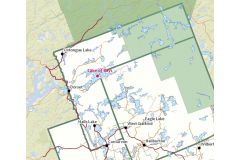Lake of Bays History
LAKE OF BAYS HISTORY
Location: Franklin Township (Muskoka District). Dorset
Origin of the Official Name:
Name given by surveyor Alexander Murray in Report for the Year of 1853. (Source: Murray, F. (1963) The Publications of the Champlain Society: Muskoka and Haliburton 1615-1875. Toronto: The Champlain Society. 176)
Scottish surveyor Alexander Murray was born in Scotland and, after a career in the Royal Navy and some experience in geological work, was appointed assistant to Sir William Logan, a provincial geologist. (Source: Murray, 1963, op. cit 156n). Murray renamed Lake of Bays, which was called The Forked Lake or Lake of Forks, a translation from the original Aboriginal work Nun ge low nee goo mark so Lake a haga (also called Nagatoagomon Lake).
The fur trade was one of the first concrete relationships that arose between Natives and non-Natives in Canada. Fur traders were almost always English or French and the trappers were Aboriginal. However, in Haliburton, many of the trappers were White too (Source: Murray, F. 1963 op cit xcv). There is evidence of the fur trade in Haliburton remembered in some of the lake names. Trading Bay and Trading Lake (one of the names given to Lake of Bays) are two such lakes which tell of the (hi)story of the fur trade in Haliburton. “Alexander Shirreff said in 1829 that Trading Lake (now Lake of Bays) appears to have been long a principle station of the traders” (Source: Murray 1963 op cit xcvii).
Also Known As:
• Trading Lake (MNR archives) "This lake was referred to as Trading Lake by the Indians from the fact that an Indian, one Bigwin from Snake Island in Lake Simcoe, traded somewhat with those Indians in that lake" (Source: Murray 1963, op. cit 176)
• Trading Lake “(now Lake of Bays) appears to have been long a principal station of the traders" (Source: Murray 1963, op. cit, xcvii).
• Ceder Narrows is the name given to this lake in 1864 by Walter Beaty in a report to the Commissioner of Crown Lands on developments related to the building of the Bobcaygeon Road (Source: Murray 1963, op. cit, 209).
• Forked Lake (MNR archives) “On passing through the lake in 1837, geographer David Thompson referred to [this lake] as Forked Lake" (Source: Rayburn, A. (1997). Place Names of Ontario. Toronto, Buffalo, London: University of Toronto Press. 186).
• The Forked Lake (Source: Murray 1963, op. cit, 91n)
• Lake of Forks (Source: Murray 1963, op. cit, 91n)
• Lake of the Forks In "Report of the Survey of Rivers, Lakes, etc" Thompson says: This Lake is called by the Natives Nun ge low e nee goo mark Lak a hagan or the Lake of Forks from the many deep Bays and points of Land [ ... ] Nun ge low e nee goo mark so Lak a hagan or the Lake of the Forks from its many deep Bays and Points of Land ... The Forked Lake may be called, for this part of the Country, a large lake" (Source: Murray 1963, op. cit, 91n).
• Nun ge low e nee goo mark Lak a hagan (Source: Murray 1963, op. cit, 91n). "The ending 'Lak a hagan' is a very corrupted version of the ending 'zagagon', which means 'lake'. This particular pronunciation is an example of the “|” dialect in Ojibwa" (Source: Macdonald, C. personal communications with researcher Elinor Widden, 1998. Craig Macdonald is connected to Friends of Algonquin Park. He is an expert on Aboriginal languages and knows much of the history of First Nations people in the Haliburton and Muskoka regions.)
• Nun ge low e nee goo mark so Lak a hagan (Source: Murray 1963, op. cit, 91n).
• Nagatoagomon Lake name cited in FH Baddeley's exploring report 1836-7 (Source: Murray 1963, op. cit, 76). This same name is also used by Baddeley to refer to the Muskoka River: "This river Nagatoamon we are now in is the same as that described by Alexr Sherriff, Esqr. in his Topographical notices[ ... ] he there calls it Muskoka river but hints, that among the indians, it has another name" (Source: Murray 1963, op. cit 16).
• "Nagatoagomon may be a very corrupted version of the word 'Ne-na-tick-go', which means 'maple" ' (Source: Macdonald, C. personal communications with researcher Elinor Widden, 1998.) Craig Macdonald is connected to Friends of Algonquin Park. He is an expert on Aboriginal languages and knows much of the history of First Nations people in the Haliburton and Muskoka regions.
Much of the Aboriginal presence in Haliburton County was erased with the arrival of Europeans. Many of Haliburton's lakes were already named before White people came to the area. However, names were changed and replaced by Whites to reflect their own (hi)story. The use of new these names erased the (hi)story of Aboriginal people.
The above information came from: Discovering the (Hi)story of Haliburton Through Its Lakes' Names by Elinor Whidden, a student report prepared for Trent University- Bioregionalism Course, 1998. From the U-Links Centre for Community-Based Research Collection.